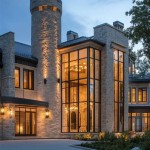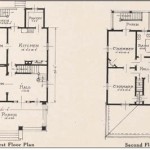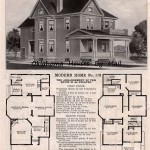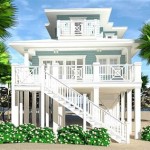Circular House Plans refer to architectural designs that incorporate curved walls and a circular layout. These designs are gaining popularity due to their unique aesthetic appeal, energy efficiency, and functional advantages. In contrast to traditional rectangular or square homes, circular houses offer distinctive architectural features and a more organic flow of space.
The circular shape of these houses allows for efficient use of space, reducing energy loss and improving temperature regulation. The absence of sharp corners and long corridors creates a sense of spaciousness and promotes natural ventilation. An intriguing example of a circular house plan is the Nautilus House in Mexico, designed by renowned architect Javier Senosiain. This stunning residence features a spiraling arrangement of rooms with curved walls, providing ample natural light and a harmonious living environment.
Moving forward, this article will delve deeper into the benefits, challenges, and design considerations associated with circular house plans. We will explore how these architectural marvels enhance energy efficiency, promote well-being, and offer a unique and captivating living experience.
Circular house plans offer a range of advantages, including:
- Energy efficiency
- Improved natural ventilation
- Sense of spaciousness
- Unique aesthetic appeal
- Reduced energy loss
- Promotes well-being
- Space optimization
- Enhanced architectural value
- Organic flow of space
These architectural designs provide a sustainable and aesthetically pleasing living environment.
Energy efficiency
Circular house plans offer superior energy efficiency compared to traditional rectangular or square homes. The curved walls and circular layout minimize heat loss and improve airflow, reducing the need for heating and cooling systems.
The absence of sharp corners eliminates thermal bridges, which are areas where heat can easily escape. The continuous curvature of the walls creates a more uniform distribution of temperature throughout the house, reducing energy loss and increasing comfort.
Additionally, the circular shape allows for optimal placement of windows and skylights, maximizing natural light and passive solar heating. The strategic positioning of these openings allows the sun’s warmth to enter the house during winter months, reducing reliance on artificial heating sources.
Overall, the energy-efficient design of circular house plans can significantly lower energy consumption, resulting in reduced utility bills and a more sustainable living environment.
In addition to the energy-saving benefits mentioned above, circular house plans can also promote well-being and enhance the overall living experience. The organic flow of space and the absence of sharp corners create a calming and harmonious atmosphere, reducing stress and promoting relaxation.
Improved natural ventilation
Circular house plans facilitate improved natural ventilation compared to traditional rectangular or square homes. The curved walls and circular layout promote efficient airflow, creating a healthier and more comfortable living environment.
- Continuous airflow
The circular shape of the house allows for continuous airflow, as there are no corners or obstacles to impede the movement of air. This constant air circulation helps to remove stale air, reduce humidity, and maintain a fresh and healthy indoor environment.
- Stack effect
The stack effect, which is the natural movement of air due to temperature differences, is enhanced in circular house plans. The warm air rises and escapes through strategically placed vents or windows at the top of the house, while cooler air is drawn in from lower openings. This creates a natural ventilation system that helps to regulate temperature and improve air quality.
- Cross-ventilation
Cross-ventilation is the movement of air through openings on opposite sides of the house. Circular house plans allow for easy implementation of cross-ventilation, as the curved walls facilitate the flow of air from one side to the other. This helps to cool the house down during hot weather and provides fresh air throughout the living space.
- Optimized window placement
Circular house plans allow for optimal placement of windows and skylights, which can be strategically positioned to capture prevailing breezes and maximize natural light. This thoughtful placement enhances natural ventilation and reduces the reliance on artificial lighting and mechanical ventilation systems.
Overall, the improved natural ventilation in circular house plans contributes to a healthier, more comfortable, and energy-efficient living environment.
Sense of spaciousness
Circular house plans create a unique sense of spaciousness that is not typically found in traditional rectangular or square homes.
- Continuous flow of space
The curved walls and circular layout of circular house plans eliminate sharp corners and long corridors, creating a continuous flow of space. This uninterrupted flow makes the house feel larger and more open, even if the square footage is comparable to a traditional home.
- Reduced visual barriers
The absence of sharp corners and walls that intersect at right angles reduces visual barriers, allowing the eye to travel freely throughout the space. This open sightline contributes to the feeling of spaciousness and makes the house feel larger than it actually is.
- Natural light distribution
Circular house plans allow for strategic placement of windows and skylights, which can be positioned to maximize natural light. The curved walls facilitate the distribution of natural light throughout the living space, reducing the need for artificial lighting and creating a brighter and more inviting atmosphere.
- Efficient use of space
Circular house plans make efficient use of space by eliminating wasted corners and awkward angles. The curved walls allow for furniture and other objects to be arranged in a more fluid and space-saving manner, contributing to the overall sense of spaciousness.
The combination of these factors creates a house that feels larger, more open, and more inviting than its square footage might suggest. Circular house plans offer a unique and spacious living environment that promotes a sense of well-being and comfort.
Unique aesthetic appeal
Circular house plans offer a unique and striking aesthetic appeal that sets them apart from traditional rectangular or square homes.
- Organic and fluid forms
The curved walls and circular layout of circular house plans create organic and fluid forms that are reminiscent of nature. The absence of sharp corners and straight lines lends a sense of harmony and balance to the overall design, resulting in a visually pleasing and inviting living space.
- Sculptural quality
Circular house plans often have a sculptural quality, with the curved walls and roof forming a cohesive and visually striking form. The interplay of light and shadow on the curved surfaces creates a dynamic and ever-changing appearance, adding depth and interest to the exterior of the house.
- Connection to nature
The organic forms of circular house plans create a strong connection to nature. The curved walls and rounded edges mimic the shapes found in nature, such as rolling hills and flowing water, evoking a sense of tranquility and serenity within the living space.
- Timeless design
Circular house plans have a timeless and enduring aesthetic appeal. The organic and fluid forms transcend architectural trends and styles, resulting in homes that remain visually stunning for generations to come.
The unique aesthetic appeal of circular house plans captivates the eye and creates a truly exceptional living environment. The curved walls, fluid forms, and sculptural quality combine to produce homes that are both visually striking and deeply connected to nature.
Reduced energy loss
Circular house plans offer reduced energy loss compared to traditional rectangular or square homes due to several key factors:
- Continuous thermal envelope
The curved walls of a circular house create a continuous thermal envelope, which minimizes heat loss through conduction. Unlike traditional homes with corners and sharp angles, where heat can easily escape through thermal bridges, circular homes have a smooth and uninterrupted exterior surface that reduces heat transfer.
- Optimized surface area
Circular house plans have a smaller surface area compared to rectangular or square homes with the same square footage. This reduced surface area means that there is less area for heat to escape, resulting in lower energy loss.
- Improved insulation
The curved walls of circular homes allow for thicker and more effective insulation to be installed. The continuous nature of the walls eliminates thermal bridges and provides a better seal against air infiltration, reducing heat loss and improving energy efficiency.
- Passive solar heating
The curved shape of circular homes allows for optimal placement of windows and skylights to maximize passive solar heating. The south-facing curved wall can be designed to capture the sun’s warmth during winter months, reducing the need for artificial heating sources and further reducing energy loss.
Overall, the combination of these factors contributes to the reduced energy loss in circular house plans, resulting in lower energy bills and a more sustainable living environment.
In addition to the energy-saving benefits mentioned above, circular house plans can also promote well-being and enhance the overall living experience. The organic flow of space and the absence of sharp corners create a calming and harmonious atmosphere, reducing stress and promoting relaxation.
Promotes well-being
Circular house plans promote well-being in several ways:
- Reduced stress and anxiety
The curved walls and organic flow of space in circular house plans create a calming and harmonious atmosphere. The absence of sharp corners and long corridors reduces visual clutter and cognitive stimulation, which can contribute to feelings of stress and anxiety. The continuous flow of space allows for easy movement and promotes a sense of openness and freedom, fostering a relaxed and stress-free living environment.
- Improved sleep quality
The calming atmosphere and reduced visual stimulation in circular house plans can promote better sleep quality. The curved walls help to minimize noise pollution and create a more peaceful and restful sleep environment. Additionally, the strategic placement of windows and skylights can allow for natural light to fill the bedroom during the day, which can help regulate the body’s natural sleep-wake cycle.
- Enhanced mood and emotional well-being
The organic forms and natural flow of space in circular house plans can have a positive impact on mood and emotional well-being. The curved walls and rounded edges mimic the shapes found in nature, which have been shown to have a calming and restorative effect on the human psyche. The absence of sharp corners and long corridors reduces feelings of confinement and promotes a sense of spaciousness and freedom, which can contribute to improved mood and overall well-being.
- Increased physical activity
The continuous flow of space in circular house plans encourages movement and physical activity. The open and inviting layout makes it easy to move around the house without encountering obstacles or dead ends. This can promote increased physical activity, which is essential for overall health and well-being.
Overall, the unique design features of circular house plans create a living environment that is conducive to well-being, promoting relaxation, reducing stress, improving sleep quality, enhancing mood, and encouraging physical activity.
In addition to the well-being benefits mentioned above, circular house plans also offer a number of practical advantages. The curved walls and circular layout allow for efficient use of space, reduced energy loss, and improved natural ventilation. These factors contribute to a more sustainable and comfortable living environment.
Space optimization
Circular house plans offer exceptional space optimization compared to traditional rectangular or square homes due to their unique shape and layout. Here are several key ways in which circular house plans maximize space:
- Elimination of wasted space
Rectangular and square homes often have wasted space in corners and odd-shaped areas. Circular house plans, with their continuous curved walls, eliminate these wasted spaces, allowing for more efficient use of the available square footage.
- Flexible and adaptable layout
The circular layout provides flexibility and adaptability in terms of room arrangement. Rooms can be arranged in a variety of ways to suit the needs and preferences of the occupants, without being constrained by rigid walls and corners.
- Multi-purpose spaces
The open and flowing layout of circular house plans encourages the use of multi-purpose spaces. Rooms can be designed to serve multiple functions, such as a living room that also serves as a dining area or a bedroom that incorporates a study space.
- Reduced circulation space
Circular house plans often require less circulation space compared to traditional homes. The continuous flow of space eliminates the need for long hallways and corridors, freeing up additional space for living areas.
Overall, the space-saving features of circular house plans allow for more efficient use of the available square footage, resulting in homes that feel larger and more spacious than their actual size.
In addition to the space-saving benefits mentioned above, circular house plans can also promote well-being and enhance the overall living experience. The organic flow of space and the absence of sharp corners create a calming and harmonious atmosphere, reducing stress and promoting relaxation.
Enhanced architectural value
Circular house plans offer enhanced architectural value due to their unique and visually striking design:
- Organic and fluid forms
The curved walls and circular layout of circular house plans create organic and fluid forms that are reminiscent of nature. This departure from traditional rectilinear architecture results in homes that are visually appealing and stand out from the ordinary.
- Sculptural quality
Circular house plans often have a sculptural quality, with the curved walls and roof forming a cohesive and visually striking form. The interplay of light and shadow on the curved surfaces creates a dynamic and ever-changing appearance, adding depth and interest to the exterior of the house.
- Connection to nature
The organic forms of circular house plans create a strong connection to nature. The curved walls and rounded edges mimic the shapes found in nature, such as rolling hills and flowing water, evoking a sense of tranquility and serenity within the living space.
- Timeless design
Circular house plans have a timeless and enduring aesthetic appeal. The organic and fluid forms transcend architectural trends and styles, resulting in homes that remain visually stunning for generations to come.
The unique architectural features of circular house plans enhance their overall value and create homes that are not only functional but also aesthetically pleasing. Their organic forms, sculptural quality, connection to nature, and timeless design make them highly desirable and sought-after by homeowners who appreciate exceptional architecture.
Organic flow of space
Circular house plans embrace an organic flow of space, characterized by the absence of sharp corners and long corridors. This unique design approach fosters a harmonious and inviting living environment with several key benefits:
- Enhanced movement and accessibility
The continuous curved walls and circular layout eliminate obstacles and create a seamless flow of space. This open and accessible design allows for effortless movement throughout the house, making it ideal for families with young children, individuals with mobility impairments, or those who simply appreciate a more fluid living environment.
- Improved natural light distribution
The organic flow of space allows for optimal placement of windows and skylights, maximizing the penetration of natural light. The curved walls and rounded edges help to diffuse and distribute light evenly throughout the interior, creating a bright and airy atmosphere that reduces the reliance on artificial lighting.
- Visual continuity and spaciousness
The absence of sharp corners and long corridors creates a sense of visual continuity and spaciousness. The smooth transition between rooms and the elimination of visual barriers enhance the perceived size of the house and promote a more.
- Reduced noise pollution
The organic flow of space helps to minimize noise pollution within the house. The curved walls and rounded edges act as natural sound diffusers, absorbing and scattering sound waves. This creates a quieter and more peaceful living environment, particularly in open-plan layouts where sound can easily travel.
Overall, the organic flow of space in circular house plans contributes to a more comfortable, inviting, and harmonious living environment. The absence of sharp corners and long corridors promotes accessibility, maximizes natural light, enhances spaciousness, and reduces noise pollution, creating a truly exceptional living experience.










Related Posts








